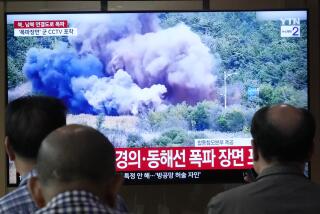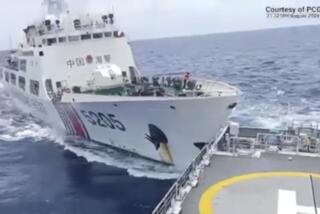Koreans Battle in Yellow Sea
- Share via
TOKYO — South Korea said four of its sailors were killed, 22 injured and one missing this morning after a North Korean naval vessel opened fire on two South Korean patrol boats in the Yellow Sea.
South Korean military officials said two of the South’s vessels were warning two North Korean military vessels that had crossed the maritime border, known as the Northern Limit Line, when they were fired upon unexpectedly by high-caliber guns about 10:30 a.m. The South Koreans returned fire.
The four South Korean men killed were on the deck of one boat, which later sank. Lt. Gen. Lee Sang Hee with South Korea’s Ministry of Defense said it’s believed that the 122-foot-long vessel was hit with an 85-millimeter gun.
The number of casualties on the North Korean side was not immediately known, although the North’s 136-foot vessels are each capable of carrying up to 50 people. Television footage showed both a North Korean and a South Korean vessel with black smoke trailing behind being towed by South Korean vessels.
The North Korean vessels were said to be accompanying a fleet of up to 30 fishing boats, although according to one report only the two naval vessels had crossed into South Korean territory. One was reportedly about three miles south of the maritime border, the other 1.8 miles.
The area where the deadly face-off occurred, near Yonpyong Island, has witnessed several past confrontations around this time of year, when crab is plentiful. “We heard gunshots but thought it was just routine training,” Yonpyong villager Park Gun Sok told local reporters. North Korea has refused to recognize the maritime line of separation and had no immediate comment on today’s conflict.
As with all North Korean incursions, a key question is whether this one was intentional and, if so, what the motivation was. “The fact is, we were fired upon first by North Korea and we suffered casualties,” said the Defense Ministry’s Lee at a hastily called news conference. “So we believe it was a calculated attempt.”
The South Korean vessel that took the direct hit was believed to be within 500 yards of the North Korean vessel when it was attacked. It sank a short time later. South Korean officials said they believed that 30 or more North Koreans sailors may have been killed when the South Koreans returned fire.
President Kim Dae Jung called a National Security Council meeting for this afternoon. He urged its members to act on principle, not emotion.
The last major incursion happened in the same area in June 1999, also during crab season, when an estimated 30 North Korean sailors died and seven South Koreans were injured in an exchange of gunfire. The conflict also damaged two South Korean vessels and seven North Korean craft.
The latest incident will put pressure on Kim’s government to mount a political, and perhaps even some sort of military, response. It could also further discredit Kim’s long-standing belief that North Korea can be changed through gentle persuasion and could set back recent efforts at rapprochement.
Scott Snyder, Seoul-based representative with the Asia Foundation, said the Kim government will probably downplay the incident, argue that it underscores the need for dialogue and urge Washington to go ahead with a proposed high-level meeting between U.S. and North Korean representatives.
“The U.S. side’s response will be more complicated, however,” he added. The Bush administration has said all along that any improvement in U.S.-North Korean relations is premised on better North-South relations, and this clearly does little to engender trust on the peninsula.
There are 37,000 U.S. troops based in South Korea.
Lee Ki Tak, a professor of international relations and critic of the Kim administration, said there’s little doubt that this incident, which lasted about 20 minutes, was intentional. North Korean leader Kim Jong Il is threatened by the recent glory afforded to South Korea through the World Cup, Lee said.
Pyongyang chose this spot for a confrontation because it’s one of the few areas where there is no U.S. military presence, Lee said, and the power balance is more even.
“The [South Korean] government must be confused,” he said. “They’ve spent the past four years flattering North Korea.”
Today’s clash follows several border incursions by North Korean navy ships into South Korean waters in recent months.
The maritime border, which is not clearly marked, was violated a dozen times last year, South Korea claims. The two Koreas were divided in 1945 and never signed a peace agreement after the 1950-53 Korean War.
More to Read
Sign up for Essential California
The most important California stories and recommendations in your inbox every morning.
You may occasionally receive promotional content from the Los Angeles Times.













